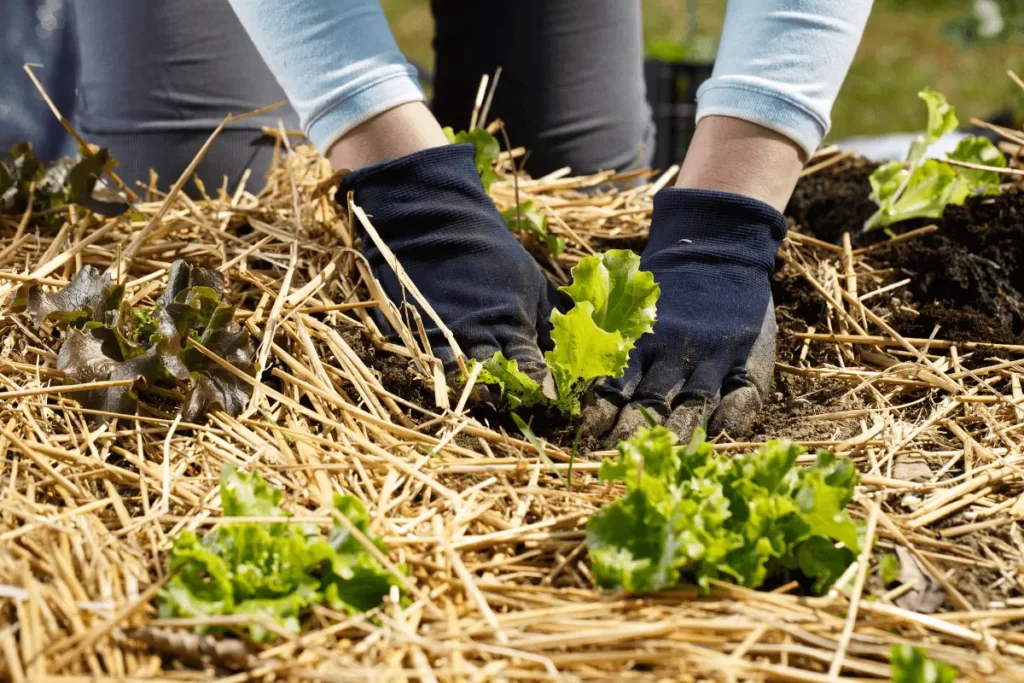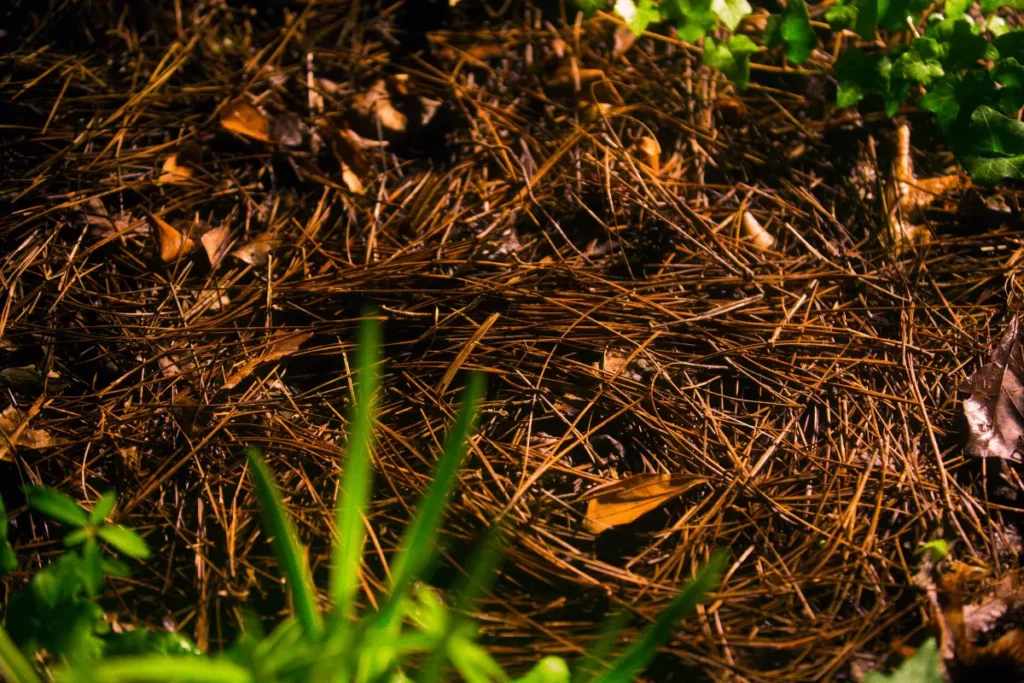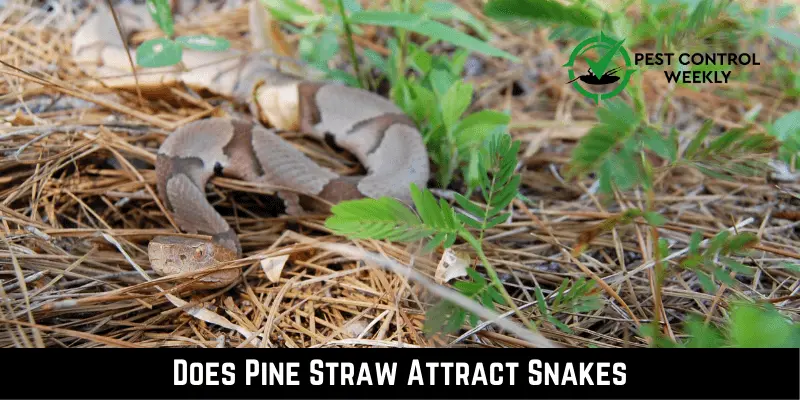Using mulch like pine straw is a common way to keep a garden healthy and full of life. Pine straw is your favorite because of its natural appearance and many benefits. But one scary question keeps coming up: “Does pine straw attract snakes?”
Pine straw doesn’t directly attract snakes. Instead, it provides conditions that snakes could like, such as a warm, cozy, and well-hidden space. Thus, a pine straw-covered garden may unintentionally attract snakes, especially if it has insects and small rodents.
Reduce the likelihood of snakes inhabiting your yard by taking the appropriate precautions. Keep reading to learn more about the connection between pine straw mulch and snakes.
What is Pine Straw?

Pine straw is a renewable resource that originates from several species of pine trees and is a gift from Mother Nature. These trees primarily shed their thin, needle-like leaves in the fall, covering the forest floor with a thick layer of mulch that is rich in nutrients.
This common substance is at home in both natural and human-made environments. Pine straw, with its range of colors from yellow to deep auburn, not only keeps soil wet and reduces weed growth but also adds visual appeal to the garden.
Uses of Pine Straw
Pine straw’s adaptability has led to many uses in many different areas. According to Ecological Engineering, it prevents soil erosion and is attractive. Pine needles form a web-like structure, which secures the soil against erosion and floods.
In addition to improving soil quality, pine straw provides a welcoming environment for soil-dwelling species including earthworms and beetles. Wreaths and baskets are only a couple of crafty things that may be fashioned from this material. Additionally, pine straw’s insulation characteristics have made it a go-to for green buildings.
Pine Straw in Gardening
According to Agroforestry Systems, garden lovers have widely welcomed pine straw as a green miracle product. Its soil moisture conservation, temperature regulation, and weed control are notable qualities. Soil fertility is increased when the decomposition process progressively releases nutrients.
As it decomposes, pine straw progressively acidifies the soil surrounding plants that thrive in acidic conditions, making it a perfect mulch. It also attracts helpful insects, which helps maintain a healthy garden environment. Despite its many benefits, it’s important to note that pine straw, like other organic material, may serve as a home to various creatures, including snakes.
Do Snakes Like Pine Straw?
The link between pine straw and snakes appears to be more coincidental than causative. Snakes are not strongly attracted to pine straws. It can, however, become a haven for these reptiles due to the warm, wet, and protected habitat it offers.
Snakes seeking food and shelter may use a pine straw layer’s underside. Therefore, while pine straw doesn’t specifically attract snakes, it may house them if the atmosphere is right. However, with careful attention and routine garden upkeep, you may prevent such disruptions and keep the peace in your green haven.
Are Snakes Attracted to Pine Straw?

Snakes are careful and secure creatures that don’t actively seek pine straw. They seek shelter, food, and temperature regulation because of their instincts. In the case of pine straw, it is not so much the pine straw itself that attracts snakes but the conditions it may create.
Fallen pine needles may provide a protected, damp atmosphere with perfect conditions for hiding and hunting. However, it’s important to remember that snakes wouldn’t specifically seek pine straw, but rather any similar habitat that meets their fundamental needs.
The Scientific Perspective
According to the scientific community, snakes’ interest in pine straw may be explained by studying their behavioral ecology. Because they can’t regulate their body temperature, snakes are considered ectothermic.
Pine straw’s insulating properties may make it a desirable habitat, particularly in colder locations or seasons. The thick vegetation also provides excellent cover for hiding, which can aid in their predatory or defensive tactics. Notably, this attraction to pine straw is an opportunistic response to local conditions rather than a natural attraction.
Anecdotal Evidence
According to myths and superstition, there appears to be a strong attraction between snakes and pine straws. There are many stories of gardeners who found snakes hiding in the pine needles. Still, it’s important to have some perspective when considering these stories. Remember that snakes can be discovered in many other settings, not just in pine straws.
These accounts have less to do with pine straw itself than the fact that it is frequently used as landscaping and that human and snake habitats sometimes overlap. In light of this, it is important to evaluate anecdotal information, such as reports of snakes around pine straw, in the greater ecological context.
Why Might Pine Straw Attract Snakes?
Habitat Preferences
Like all other forms of life, Snakes have particular needs for the environment they live in. A wide range of characteristics, including security, food accessibility, and environmental stability, determines their habitat choices.
Pine straw can accidentally fulfill several of these requirements. Its dense, tangled layers provide a maze-like environment, perfect for hiding from threats. Snakes need isolation for nesting and shedding skin, which requires a dense pine needle covering. Thus, while snakes aren’t always drawn to pine straws, the snakes who find them may find their useful properties.
Hidden Prey
Pine straw shelters many smaller animals as well as snakes. Snakes may be attracted to pine straws because of insects, rodents, and even amphibians. As opportunistic predators, Snakes tend to follow in their prey’s footsteps. The snakes may settle within the pine straw if they find their prey there. It’s important to remember that this has more to do with the hunters’ habits than with the pine straw itself.
Temperature Control
In order to maintain a comfortable body temperature, snakes use several strategies unique to their ectothermic metabolic mode. They use environmental cues like shade availability or sunlight exposure to maintain a comfortable internal temperature. Pine straw’s insulating characteristics make it an appropriate choice in this situation.
Snakes will appreciate the extra warmth the straw provides when temperatures drop. On the other hand, when the temperature outside is really high, snakes can take refuge in the cooler bottom layers of pine straw. Pine straw’s ability to moderate temperature may make it an accidental favorite of snakes looking to maintain body temperature.
How To Prevent Snakes In Your Pine Straw Garden?
Maintenance Tips
- Regular Inspection: Walk around your garden often to spot snakes and their prey.
- Management of Debris: Pick up broken limbs, leaves, and other trash as soon as possible. Venomous snakes may find shelter in such disarray.
- Water Management: Snakes seek hydration and search sites in standing water.
- Compost Discipline: Seal or fence your compost heap to keep snakes from eating it.
- Layer Management: Keep the pine straw layer at around 3 inches in height, as a deeper layer is more appealing to snakes.
Natural and Commercial Repellents
- Plant-Based Repellents: Marigold, garlic, and lemongrass are snake repellents. Snakes’ sensitivity to strong odors makes aromatic plants beneficial.
- Essential Oils: Spraying clove or cinnamon oil in your garden may deter snakes.
- Commercial Repellents: Use chemicals to repel snakes. These usually deter snakes by annoying or confusing them.
- Safety Precaution: Ensure the repellant is safe for your garden’s environment, dogs, and children.
Conclusion
As we continue down the road of knowledge, we discover that the snakes’ presence in the pine straw isn’t due to attraction but rather to adaptability and survival. These reptiles may frighten us, yet they indicate a healthy ecology.
However, keeping snakes out of the garden is important for several reasons, including security and peace of mind. We can keep our pine straw gardens pest-free by using the correct repellents and performing routine upkeep. Our gardens grow with us as we mature, nourishing plants and peace and respect for all life.
FAQs
References
Dickens, E.D., Moorhead, D.J., Bargeron, C.T. et al. A summary of pine straw yields and economic benefits in loblolly, longleaf and slash pine stands. Agroforest Syst 86, 315–321 (2012). https://doi.org/10.1007/s10457-012-9542-4
Manuel García Díaz, Manuel Esteban Lucas-Borja, Javier Gonzalez-Romero, Pedro Antonio Plaza-Alvarez, Mehdi Navidi, Yi-Fan Liu, Gao-Lin Wu, Demetrio Antonio Zema,
Effects of post-fire mulching with straw and wood chips on soil hydrology in pine forests under Mediterranean conditions, Ecological Engineering, Volume 182, 2022, 106720, ISSN 0925-8574, https://doi.org/10.1016/j.ecoleng.2022.106720.

